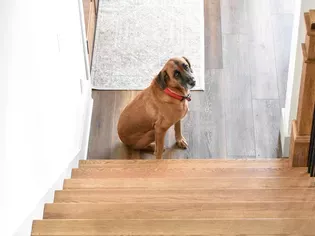What to Do When Your Dog Is Afraid of Stairs
Updated on 04/26/24

Conquering Canine Stair Anxiety: A Comprehensive Guide to Help Your Dog Overcome the Fear of Stairs
Navigating stairs can be a daunting task for some dogs, leading to anxiety and resistance. However, with patience, understanding, and effective training techniques, you can help your furry friend conquer their stair phobia. In this comprehensive guide, we delve into the common causes of dog stair anxiety and provide step-by-step strategies to overcome this issue.
Understanding the Causes of Dog Stair Anxiety
Identifying the underlying reasons behind your dog's stair anxiety is crucial for developing effective training methods. Common causes include:
* Negative Experiences: A previous fall or unpleasant encounter on stairs can trigger fear and avoidance.
* Developmental Stage: Puppies and older dogs may feel unsteady on stairs due to their developing or declining coordination.
* Physical Limitations: Dogs with joint pain, arthritis, or other mobility issues may experience discomfort or instability on stairs.
* Genetic Predisposition: Some breeds, such as greyhounds and Boston terriers, may have a higher tendency to develop stair anxiety.
* Lack of Exposure: Dogs who haven't been exposed to stairs or had positive experiences on them may become anxious when faced with them.
Overcoming Dog Stair Anxiety: A Step-by-Step Guide
With a systematic approach and positive reinforcement, you can gradually help your dog overcome their stair anxiety. Follow these steps to guide the training process:
Step 1: Start Slowly and Gradually
Avoid overwhelming your dog by starting with baby steps. Begin by placing treats or toys on the first few stairs and encourage your dog to approach. Reward them heavily for each successful try.
Step 2: Build Confidence on a Lowered Staircase
If your dog is particularly anxious, try setting up a makeshift staircase with pillows or blankets. This provides a gradual incline and reduces the height barrier, boosting their confidence.
Step 3: Introduce Positive Staircase Experiences
Once your dog is comfortable approaching the stairs, gradually increase the height and number of stairs they encounter. Continue rewarding them for calm behavior and progress.
Step 4: Practice in Different Environments
To generalize the training, practice in different locations with varied types of stairs (e.g., wooden, carpeted, outdoor). This helps your dog learn that stairs can be safe and rewarding in various settings.
Step 5: Seek Professional Help if Needed
If your dog's stair anxiety persists despite your efforts, consider seeking professional help from a veterinarian or certified animal behaviorist. They can assess underlying medical conditions or behavioral issues that may be contributing to the fear.
Additional Tips for Success
* Maintain a Calm and Patient Approach: Stay calm and relaxed during training sessions to avoid transmitting anxiety to your dog.
* Use High-Value Treats: Reward your dog with treats they find particularly irresistible to motivate their participation.
* Don't Force Your Dog: Respect your dog's pace and never force them to confront their fear.
* Avoid Punishment: Using punishment methods will only worsen your dog's anxiety and undermine the training process.
* Regular Practice: Consistency is key. Practice regularly to reinforce your dog's learning and build confidence.
Conclusion
Overcoming dog stair anxiety requires a combination of patience, understanding, and effective training techniques. By addressing the underlying causes and following the steps outlined in this guide, you can help your furry companion conquer their fear and navigate stairs with confidence. Remember to prioritize your dog's well-being and seek professional support if needed. With consistent effort and positive reinforcement, you can empower your dog to overcome this challenge and enjoy a more fulfilling life.
Explore More Pets

Basic Training
Puppy and Baby Introductions

Working Dog Breeds
All About Search and Rescue Dogs

Dog Treatments
Puppy Vaginitis: Signs, Causes and Treatment

Dog Adoption
After More Than 1,200 Days in the Shelter, Coco Goes Home

Basic Training
How to Train Your Puppy to Go on Potty Pads

Hybrid Dog Breeds
The Difference Between a Mutt, Mixed Breed, or Designer Dog?

Dog Treatments
Nail Problems in Dogs

Puppies
7 Reasons Why Two Dogs Are Better Than One